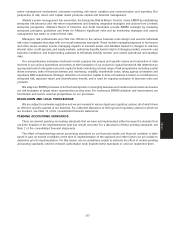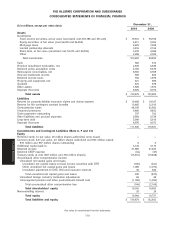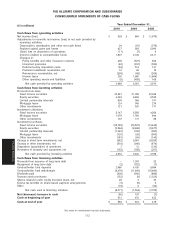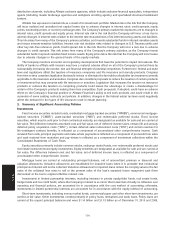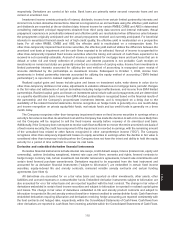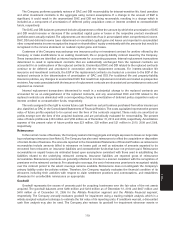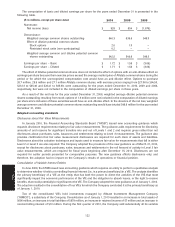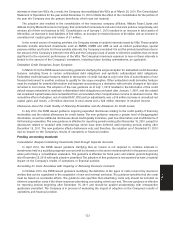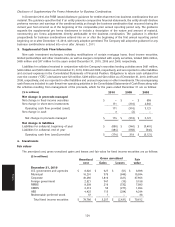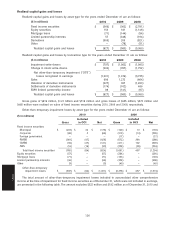Allstate 2011 Annual Report Download - page 196
Download and view the complete annual report
Please find page 196 of the 2011 Allstate annual report below. You can navigate through the pages in the report by either clicking on the pages listed below, or by using the keyword search tool below to find specific information within the annual report.
When derivatives meet specific criteria, they may be designated as accounting hedges and accounted for as fair
value, cash flow, foreign currency fair value or foreign currency cash flow hedges. The hedged item may be either all or
a specific portion of a recognized asset, liability or an unrecognized firm commitment attributable to a particular risk for
fair value hedges. At the inception of the hedge, the Company formally documents the hedging relationship and risk
management objective and strategy. The documentation identifies the hedging instrument, the hedged item, the nature
of the risk being hedged and the methodology used to assess the effectiveness of the hedging instrument in offsetting
the exposure to changes in the hedged item’s fair value attributable to the hedged risk. For a cash flow hedge, this
documentation includes the exposure to changes in the variability in cash flows attributable to the hedged risk. The
Company does not exclude any component of the change in fair value of the hedging instrument from the effectiveness
assessment. At each reporting date, the Company confirms that the hedging instrument continues to be highly effective
in offsetting the hedged risk. Ineffectiveness in fair value hedges and cash flow hedges, if any, is reported in realized
capital gains and losses.
Fair value hedges For hedging instruments used in fair value hedges, when the hedged items are investment
assets or a portion thereof, the change in fair value of the derivatives is reported in net investment income, together with
the change in the fair value of the hedged items. The change in fair value of hedging instruments used in fair value
hedges of contractholder funds liabilities or a portion thereof is reported in interest credited to contractholder funds,
together with the change in the fair value of the hedged items. Accrued periodic settlements on swaps are reported
together with the changes in fair value of the swaps in net investment income or interest credited to contractholder
funds. The amortized cost for fixed income securities, the carrying value for mortgage loans or the carrying value of the
hedged liability is adjusted for the change in the fair value of the hedged risk.
Cash flow hedges For hedging instruments used in cash flow hedges, the changes in fair value of the derivatives
representing the effective portion of the hedge are reported in accumulated other comprehensive income. Amounts are
reclassified to net investment income, realized capital gains and losses or interest expense as the hedged or forecasted
transaction affects net income. Accrued periodic settlements on derivatives used in cash flow hedges are reported in
net investment income. The amount reported in accumulated other comprehensive income for a hedged transaction is
limited to the lesser of the cumulative gain or loss on the derivative less the amount reclassified to net income, or the
cumulative gain or loss on the derivative needed to offset the cumulative change in the expected future cash flows on
the hedged transaction from inception of the hedge less the derivative gain or loss previously reclassified from
accumulated other comprehensive income to net income. If the Company expects at any time that the loss reported in
accumulated other comprehensive income would lead to a net loss on the combination of the hedging instrument and
the hedged transaction which may not be recoverable, a loss is recognized immediately in realized capital gains and
losses. If an impairment loss is recognized on an asset or an additional obligation is incurred on a liability involved in a
hedge transaction, any offsetting gain in accumulated other comprehensive income is reclassified and reported
together with the impairment loss or recognition of the obligation.
Termination of hedge accounting If, subsequent to entering into a hedge transaction, the derivative becomes
ineffective (including if the hedged item is sold or otherwise extinguished, the occurrence of a hedged forecasted
transaction is no longer probable or the hedged asset becomes other-than-temporarily impaired), the Company may
terminate the derivative position. The Company may also terminate derivative instruments or redesignate them as
non-hedge as a result of other events or circumstances. If the derivative instrument is not terminated when a fair value
hedge is no longer effective, the future gains and losses recognized on the derivative are reported in realized capital
gains and losses. When a fair value hedge is no longer effective, is redesignated as non-hedge or when the derivative
has been terminated, the fair value gain or loss on the hedged asset, liability or portion thereof which has already been
recognized in income while the hedge was in place and used to adjust the amortized cost for fixed income securities, the
carrying value for mortgage loans or the carrying value of the hedged liability, is amortized over the remaining life of the
hedged asset, liability or portion thereof, and reflected in net investment income or interest credited to contractholder
funds beginning in the period that hedge accounting is no longer applied. If the hedged item in a fair value hedge is an
asset which has become other-than-temporarily impaired, the adjustment made to the amortized cost for fixed income
securities or the carrying value for mortgage loans is subject to the accounting policies applied to
other-than-temporarily impaired assets.
When a derivative instrument used in a cash flow hedge of an existing asset or liability is no longer effective or is
terminated, the gain or loss recognized on the derivative is reclassified from accumulated other comprehensive income
to net income as the hedged risk impacts net income. If the derivative instrument is not terminated when a cash flow
hedge is no longer effective, the future gains and losses recognized on the derivative are reported in realized capital
gains and losses. When a derivative instrument used in a cash flow hedge of a forecasted transaction is terminated
because it is probable the forecasted transaction will not occur, the gain or loss recognized on the derivative is
116
Notes



